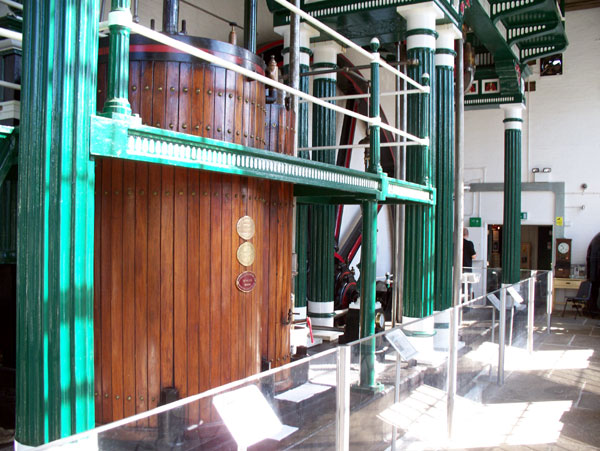
Victorian industrial building (1886) next to the River Lee, with the original Wood Bros beam pumping engine in situ and in working order.
The site was a sewage pumping and treatment station, but no longer has this function. Asides from the museum there are a cafe and other civic amenities. The buildings for the engine house, boiler house and other pumps (scrapped) still remain. The original boiler house and 2nd engine house have been converted to other uses.
The 100hp beam engine still stands in its original engine house, and was restored to working order in 2009. Steam is provided by two oil-burning boilers in a new single storey boiler room.
The ornamented design is typical of its period.
There are also some display panels about the history of the site.
Because of the cost of fuel, the engine is in steam only about once a month.
I was fortunate enough to see the engine running. It seems to be awkward to start up. 🙂 I purchased the operating instructions compiled by one of the volunteers – they run to 38 pages.
The site is worth a visit if you are interested in industrial heritage. It is at the end of Markfield Road: pass under the two railway arches and along the cobbled roadway to the left. Apparently it is OK to drive all the way down and park in the marked area next to the engine house.
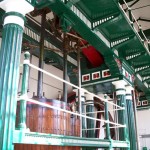
Category: Museum
Museums and collections
Buckinghamshire County Museum, Aylesbury
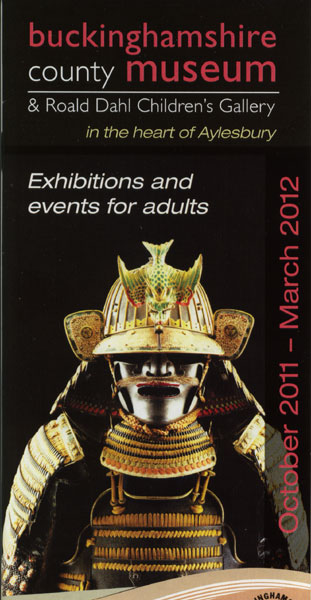 I visited the museum to see the temporary exhibition “Samurai: Warriors of Ancient Japan”. The temporary exhibition had some quality items of historical samurai armour and weapons, from a private collection, together with a few modern blades made using the traditional techniques. Worth a visit.
I visited the museum to see the temporary exhibition “Samurai: Warriors of Ancient Japan”. The temporary exhibition had some quality items of historical samurai armour and weapons, from a private collection, together with a few modern blades made using the traditional techniques. Worth a visit.
Also downstairs was an exhibition of Victoriana, and an area devoted to historic local crafts and industries, and local archaeological finds. There are some things in pull-out drawers.
Upstairs, a prime exhibit is part of the Museum buildings, the “Tudor House” whose structure dates from the Tudor period. Parts of the original wall, roof and floor structures are exposed to view.
The museum is in the old centre of Aylesbury. To visit it by car, first find somewhere you can park for about 2 hours, and then head into the old part of the town centre, looking for signs to the Museum (or the Church, which is nearby). The museum fronts onto Church St, but there is also access from the street behind.
Wellcombe Collection, London
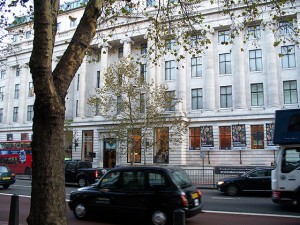 The Collection was founded by wealthy pharmaceutical magnate Sir Henry Wellcombe.
The Collection was founded by wealthy pharmaceutical magnate Sir Henry Wellcombe.
The Collection “explores the connections between medicine, life and art in the past, present and future. The venue offers visitors contemporary and historic exhibitions and collections, lively public events, the world-renowned Wellcome Library, a café, a bookshop and conference facilities.” The permanent collections on the first floor are “Medicine Man” Sir Henry’s historic collection of objects, and “Medicine Now” an exhibition of modern medicine, and also modern art inspired by medicine. On the ground floor are the temporary exhibitions, which typically are of modern art.
On my visit I looked first at “Medicine Now” which was quite interesting. Note the stacked volumes of books containing the printed human genome, the artwork of medicine pills carved by the artist to represent their function, the section of a plastinated human body, and the video of the prehistoric fish that seamlessly and slowly evolves into a man. Some people might find the historic “Medicine Man” collection more interesting, and the more gruesome items, such as the Chinese torture chair, the mummified Peruvian corpse, or the large collection of bone saws, may particularly appeal to boys. There are also paintings, masks, glassware, artificial limbs and curios. And let’s not mention the Japanese sex aids… 🙂
At the time of my visit, the temporary exhibitions included Charlie Murphy’s The Anatomy of Desire and Other Objects (glass castings of intimate body parts), Infinitas Gracias: Mexican miracle paintings (naïve paintings commissioned to give thanks), and Felicity Powell: Charmed Life – the Solace of Objects (an exhibition of objects from the historic Lovett collection of charms, plus modern art by Felicity Powel.) The Powell wax bas-reliefs were beautiful and well worth seeing.
Just as it says on the website, the Wellcombe Collection is “a free destination for the incurably curious”. I spent over 3 hours here.
To say that the Wellcombe building is well-served by public transport would be an understatement, as it’s on the south side of Euston Road, and almost opposite Euston Station. It’s also close to Euston Square underground and Euston bus station.
Sir John Soane’s Museum, London
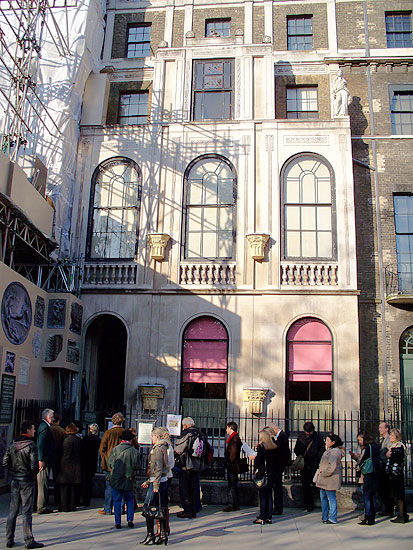 Wealthy architect and self-made man Sir John Soane bequeathed his London home and collections to a trust in 1837, stipulating that the house and collections be preserved just as they were. The collections are contained in three linked houses, nos 12, 13 and 14 on the north side of Lincoln’s Inn Fields. No.13 is the principal museum building.
Wealthy architect and self-made man Sir John Soane bequeathed his London home and collections to a trust in 1837, stipulating that the house and collections be preserved just as they were. The collections are contained in three linked houses, nos 12, 13 and 14 on the north side of Lincoln’s Inn Fields. No.13 is the principal museum building.
Today the trust is still operating and the collection is still in place. Most of the collection is housed in the rear of the three houses. No. 12 is being renovated to open eight more Soane rooms, and the front of no. 14 was bought back in 1997 for institutional use.
The ground floor library and dining room of no.13 is an opulent room with an elaborate ceiling. The many mirrors make solid walls appear to be openings leading through to another space. This is a theme too in various other parts of the house. In the rooms at the back is a huge collection of sculptured and architectural items, mostly plaster casts, but including some genuine ancient classical items. In the basement is a large stone sarcophagus, and if you get close enough to it, you can see that it is completely covered with Egyptian carvings inside and out. It is about 3000 years old. Most of the art is in the Picture Room, and two-thirds of it is hidden from view, so wait about till the attendant swings out the outer panels to reveal what is behind. On the north side the hidden art includes Hogarth’s “Rake’s Progress”, and on the south side the hidden art is architecural drawings. On the south side a second set of panels swing back to reveal, disconcertingly, a very large and deep space, with a stained glass window and sundry pictures, drawings, models and carved items now exposed.
The Breakfast Room in no. 13 is another ornate construction, with a domed ceiling and many pictures, some of them on concealed swing-out panels. Upstairs is the elegant South Drawing Room, which has openings where one would expect the windows to be, leading onto the glazed front loggia.
Currently, spotting the Museum as one approaches is a no-brainer – just head for the boxed-in scaffolding concealing no.12. The entrance is at no 13; be prepared to queue for the security check. Admission is free, but you might see more if you take the useful optional, and limited-numbers, guided tour for £5. I spent nearly 3 hours at the Soane Museum.
Nearest tube station is Holburn. There is some very expensive short-term metered parking near the Museum.
Oxford University Museum of Natural History
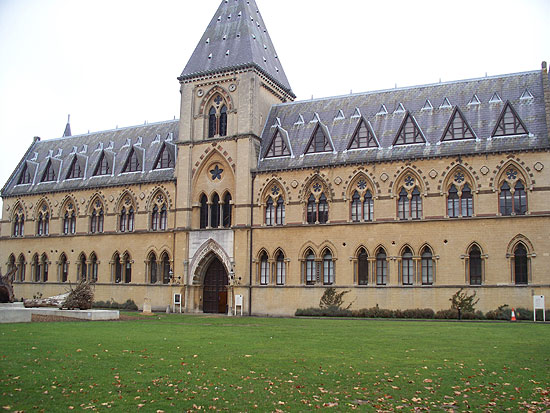
Oxford University Museums
The OUMNH is located in a spectacular Grade I listed neo-Gothic building in Parks Road. Among its most famous features are the Oxfordshire dinosaurs, the dodo, and the swifts in the tower. The Museum’s permanent exhibits are devoted to the history and diversity of life on earth, and to the rocks and minerals from which it is formed. The Museum is an important centre for research and teaching, and is organised into four collections: entomology, geology, mineralogy and petrology, and zoology. It also houses several research libraries, and is home to an environmental archaeology unit.
I spent about an hour in the OUMNH and mainly looked at the dinosaur and mammal skeletons, with a quick look at the insects and other things in the gallery. It’s well worth a visit, and one could spend longer there.
Don’t miss looking at the pillars supporting the upper galleries. Each one is made from a different mineral, identified on the base. Note also the spectacular vaulted metal and glass roof.
I recommend looking at the Museum’s website to help plan your visit.
Practical details: Admission is free. There is no museum café in the Pitt Rivers or the OUMNH, and nothing obvious outside. Travel: Arrival by car is not recommended. The Museum is easily accessible by Park and Ride. The council now charges £1.50 for Park & Ride parking, so have this with you in coin in case you see a bus about to depart! You are not required to display the ticket.
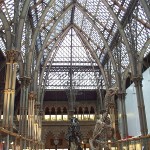
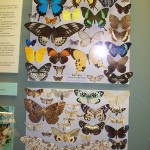
Pitt Rivers Museum, Oxford
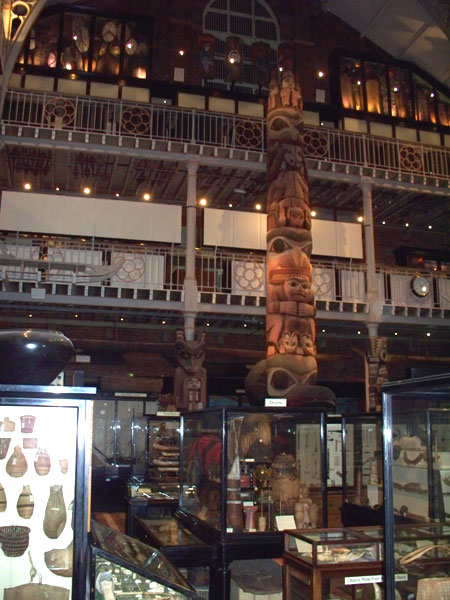 Oxford University Museums
Oxford University Museums
The Pitt Rivers Museum is located behind the OU Museum of Natural History in Parks Road, and is reached by walking through the OUMNH. The Pitt Rivers Museum cares for the University of Oxford’s collection of anthropology and world archaeology.
Permanent displays in the Museum are ethnographic and archaeological and include the following:
Pacific island objects, a collection of ceremonial brasses and ivories from the Kingdom of Benin; a fine group of early masks worn by actors in Japanese Noh dramas; more masks from Africa, Melanesia and North America; sculpture from all over the world in wood, pottery, metal and stone; boats, ranging from full-sized sailing craft to model canoes; baskets in all possible shapes and sizes; pottery from Africa and the Americas, including many pre-Columbian pieces; costumes from North America; magic objects; locks and keys; tools and weapons; musical instruments.
The cases appear to be very crowded, as a very large percentage of the collection is on view. In some instances the ‘displays’ are primarily visible storage, due to the museum being first and foremost a teaching and research institution and the curators are also university lecturers in either cultural anthropology or prehistoric archaeology.
I spent several hours in the Museum. The sheer variety of objects is fascinating, and some are of great interest, while others, like the mummified vulture head, seem a bit mad. Note the fine collection of Japanese Noh masks, the religious objects, or the shrunken heads. The cases are often dimly lit – the Museum apparently can supply torches, or you could bring your own!
I recommend looking at the Museum’s website to help plan your visit.
Practical details: Admission is free. There is no museum café in the Pitt Rivers or the OUMNH, and nothing obvious outside. Travel: Arrival by car is not recommended. The Museum is easily accessible by Park and Ride. The council now charges £1.50 for Park & Ride parking, so have this with you in coin in case you see a bus about to depart! You are not required to display the ticket.
Museum of the History of Science, Oxford
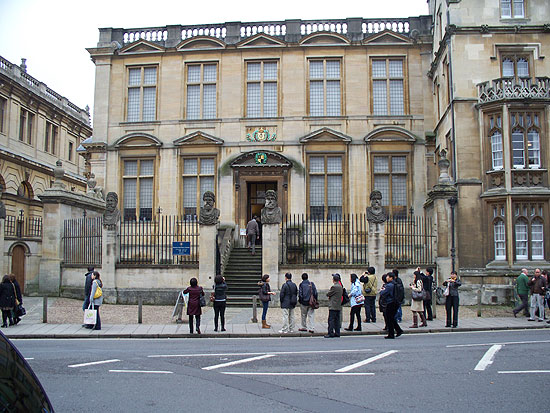
Oxford University Museums
The museum is housed in the world’s oldest surviving purpose-built museum building, in Broad Street. The present collection of the Museum preserves the material relics of past science. Particular strengths include the collections of astrolabes, sundials, quadrants, early mathematical instruments generally (including those used for surveying, drawing, calculating, astronomy and navigation) and optical instruments (including microscopes, telescopes and cameras), together with apparatus associated with chemistry, natural philosophy and medicine.
In case this sounda a bit dry, I should point out that the Museum also has special exhibitions from time to time, and these have included Steampunk Art, and Eccentricity (eccentric objects and behaviour.)
I spent several hours in the museum, and I remember large amounts of polished brass, and a vast collection of astrolabes of all sizes and materials, and different designs, some elaborately engraved.
I recommend looking at the Museum’s website to help plan your visit.
Practical details: Admission is free. The Museum is closed on Mondays. There is no museum café, but you should find refreshments in busy Broad Street. Travel: Arrival by car is not advised. The Museum is easily accessible by Park and Ride. The council now charges £1.50 for Park & Ride parking, so have this with you in coin in case you see a bus about to depart! You are not required to display the ticket.
Ashmolean Museum, Oxford
Oxford University Museums
The Ashmolean, a museum of art and archaeology, is housed in an elegant classically-fronted building in Beaumont Street. Collections include antiquities, Western art, Eastern art, coins, and a cast gallery. Western Art includes some Old Masters. Each of the four main floors has an Orientation Gallery to help you decide what to look at first.
Looking at everything in the Ashmolean would be a major effort, so it would be as well to go armed with some idea of what you want to look at first. If you don’t, there are four Orientation Galleries to help you decide what you are really interested in. I spent several hours in the museum, with a break for lunch, and had a look in most of the galleries, including the coins, and the Japanese galleries (the Japanese collection is in just two rooms). The museum is well worth a visit, and you should fnd something to interest you.
I recommend looking at the Museum’s website to help plan your visit.
Practical details: Admission is free. The Museum is closed on Mondays. There is a museum café in the basement. Travel: easily accessible by Park and Ride. The council now charges £1.50 for Park & Ride parking, so have this with you in coin in case you see a bus about to depart! You are not required to display the ticket.
Dartmoor Prison Museum, Devon
The Museum is about 150 yards from Dartmoor Prison, and housed in a building that used to be the prison dairy. It is the only museum run by HM Prison Service to be open to the public. The Museum narrates the history of the prison, and also includes the “Black Museum” of weapons and other items confiscated from prisoners, a collection of manacles and weapons, details of famous prisoners, insignia and uniforms, and the Prison today.
I recall that this was quite an interesting visit.
There is a small admission charge. Free car parking. Note that the Museum closes for lunch.
Cowper and Newton Museum, Bucks
The Museum is situated in a large 17th century house facing the marketplace in Olney. It was the home from 1768-1786 of the poet William Cowper and his companion Mary Unwin. The Rev John Newton, slave trader turned abolitionist and hymn writer, lived nearby at the Vicarage. The building contains two separate houses, known as Gilpin House and Orchard Side, and there are a Georgian walled flower garden and a Victorian kitchen garden at the rear. Today, the building contains museum displays devoted to both men and to local history.
The museum makes an interesting visit,as the displays inform one about both men and about the slave trade, and local history including the local lace-making industry. The 17th century house itself, with its slightly uneven floors and its mezzanine rooms at the back, is an interesting object. The gardens are also worth investigating, and when I visited there was some sort of historical re-enactment going on in the rear one.
Admission charge.
